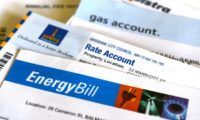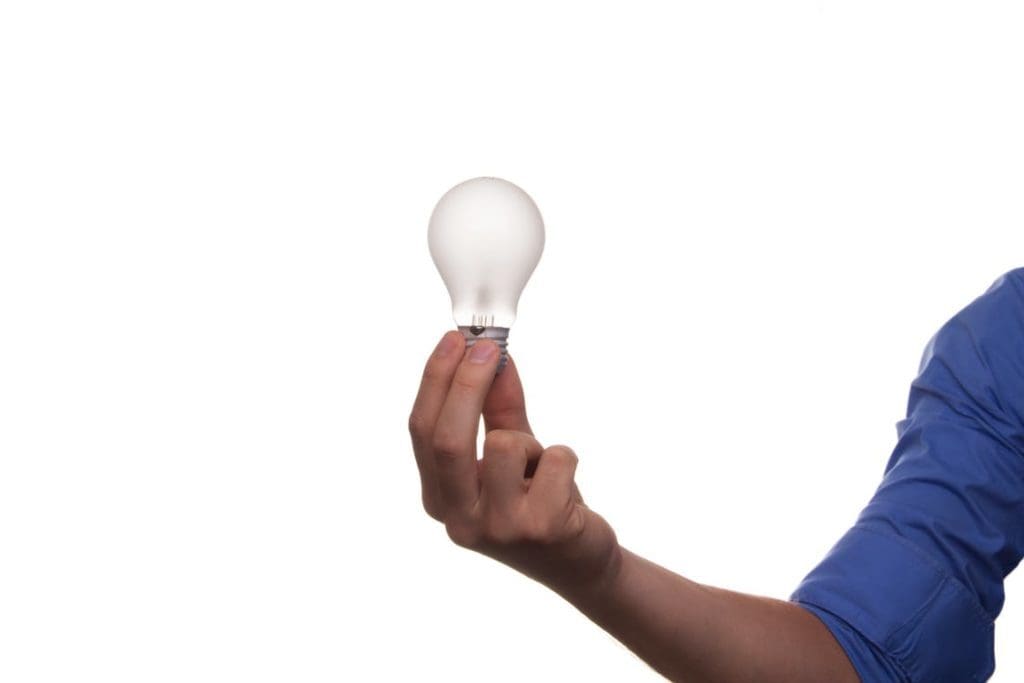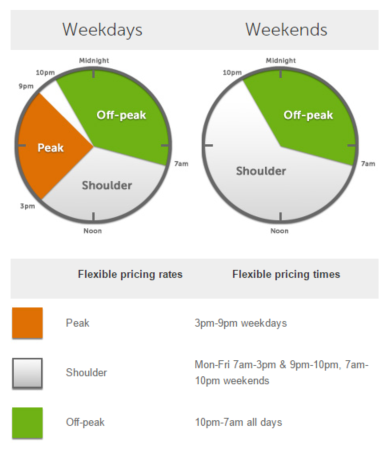If you’re connected to the grid and own your home, you pay for electricity. In most places, in Australia, there are basically two types of tariffs:
- Flat rate tariffs (aka ‘peak only’ tariffs), where you pay a fixed amount for each kilowatt-hour (kWh) of energy that your home draws from the grid, or
- Time of use tariffs (TOU, aka ‘flexible pricing’), where the amount you pay for each kWh of energy depends on when you use it (e.g. in the evening or the morning).
In this article we take a look at both of these tariff types and how well they work with solar & batteries.
 How do you know if you’re on flat rate or TOU?
How do you know if you’re on flat rate or TOU?
Congratulations! By asking this question you’re one step closer to taking control of your energy bills. Unfortunately, most people don’t know which type of tariff they’re on, which means that most people are not in a good position to effectively deal with the challenge of reducing their bills.
You can find out which type of tariff you’re on by doing any of the following:
- Look at your electricity bill. If you see line items under the charges section about ‘peak’ or ‘off-peak’ (and also ‘shoulder’, depending on where you are), then you’re probably on a TOU tariff. If you see only ‘peak’ charges or something about ‘all times’, then you’re probably on a flat rate.
- Note, however, that if you have a controlled load (e.g. for your hot water tank) this may appear as ‘controlled load off-peak’. You can have a controlled load even on a flat rate tariffs, so don’t get this confused with TOU off peak.
- Call your electricity retailer (the company who bills you for electricity). This might also involve looking at your electricity bill (to get their contact number!), but it should get you an answer in no uncertain terms. If their customer service is any good, they should be able to get you an answer quickly.
- Call your local network company (the company that manages the physical infrastructure that delivers electricity to your home). They’ll be able to tell you what kind of metering setup you’re on – which often indicates which type of tariff you’re on.
How do you know if flat or TOU would be better for you?
Here’s the deal in a nutshell: With a flat rate tariff, you have no incentive to shift your electricity consumption to different times of day to save money (unless you’ve got solar – in which case you should aim to put your solar power to use by using appliances during the day).
On a TOU tariff, however, you can save money by running appliances when grid electricity is cheaper – usually early mornings or late at night. If you run these devices during ‘peak times’, you’ll pay more. This is why TOU tariffs are sometimes referred to as ‘flexible’ tariffs: they give you an option to save money by changing your behaviour (where convenient).
A typical schedule for a TOU tariff. (Example via Energy Australia.)

Questions to ask yourself before making a switch
Most Australians are on flat tariffs, so typically the question (if the option is considered at all) is about whether to switch to TOU billing or stay with a flat rate. In which case you’ll want to ask yourself:
- Do you use a lot of electricity during the late afternoon or early evening? This is prime ‘peak’ pricing time (see a full list of schedules by state & network here). If you do, you’re probably better off on a flat rate – especially if you answer ‘no’ to the next question:
- Are you able to shift some of your daytime loads to earlier in the day or the middle of the night? The more energy consumption you can shift away from those times of day, the more you’ll save. For example, if you’re someone who does their washing & tumble drying at night, can you switch it to the early morning instead? If you think you can, then switching to TOU might actually save you more money.
Also keep in mind that you can ask your retailer for your half-hourly energy consumption data and they’re obliged to give it to you (if you have an interval-tracking meter, that is). Many energy monitoring systems will also allow you to get a detailed understanding of your consumption habits.
 Finding the answers you seek
Finding the answers you seek
A definitive answer about which is better for your home comes down to both how you respond to the questions above, as well as whether you’ve got solar panels and battery storage. Unfortunately, we can’t say out of the blue which one would be better for you, but we can point out some tools that might help.
- Our Solar & Battery Storage Sizing & Payback Estimator allows you to see what your bills might look like under flat vs TOU scenarios – with or without solar & battery storage. (Results are of course indicative only.)
- You can use this electricity plan comparison tool to plug in usage details from previous electricity bills and compare retail electricity plans. While it doesn’t explicitly allow you to compare TOU vs flat rates, but if you can work out how many kilowatt-hours (kWh) of electricity you use during different times of day, you can do the comparison yourself. (This is a pretty advanced approach that may only be of interest to the highly engaged electricity user – and would probably require the use of some kind of energy monitoring or management system – see below.)
- An energy monitoring or management system will allow you to work out how much electricity you’re using at what time of day – to then do some rough calculations for yourself.
Time of use rates can differ substantially by plan. That’s important!
Not all retail electricity plans are created equal – retailers set their rates as they see fit in most places in Australia, which means you’ve got to shop around, whether you’re looking at flat rate plans or TOU plans.
TOU plans can be particularly tricky to navigate, however, because there are more variables involved. For example, you might have a plan where the c/kWh price difference between peak, shoulder & off-peak rates is relatively small (e.g. 32c/kWh, 23c/kWh and 18c/kWh, respectively). Meanwhile, another plan where there’s a large difference between rates – say 40c/kWh for peak, 18c/kWh for shoulder and 15c/kWh for off-peak. The latter plan offers more opportunity for savings if you manage to shift your consumption to off-peak & shoulder times, but could end up being pricier if your consumption habits are pretty inflexible.
To compare rates & outcomes, we recommend our Solar & Battery Calculator.
Saving even more with tariff arbitrage & batteries
If you’re on TOU billing and have battery storage, ‘tariff arbitrage‘ is a cool trick that you can do to save a bit of extra money by playing the differential between your off peak vs peak/shoulder rates. Basically, you charge up your batteries using early morning off-peak rates in preparation for a cloudy or rainy day, when you won’t have as much solar energy available. This functionality generally requires an energy management system or smart inverter. (You can also check out our previous article about whether you might be better off on TOU or flat rate with batteries.)
Do you even have a choice between flat & TOU?
You always have a choice – but whether you have to pay for it depends on the physical metering device(s) that are wired up to your home.
If you a hard-wired metering setup (which could be analog or digital), then switching will require an electrician to come out to your home to physically switch over your metering gear – which will cost you money in most cases. Keep these potential charges in mind when trying to work out whether working out whether a switch is worth it for you.
If you have a smart meter your retailer or network company might be able to switch you over remotely for a small fee or for free – although they may limit the number of times per year you can make this request.
Some examples for Sydney & Brisbane
We’ve talked a lot here in hypotheticals, so we decided to run some numbers using our Solar & Battery Calculator to see how a range of different situations in Brisbane & Sydney square up against one another.
(We also tried looking at Melbourne but the retail markets vary so widely as to make an indicative, at-a-glance comparison very tricky to do – check out SwitchOn.vic.gov.au to have a go at it yourself. Similarly, Adelaide really only has one TOU offer at this point in time, and it’s coupled with a demand charge, making it extra hard to meaningfully model.)
The results are contained in the table below (which you can click to enlarge). We know it looks pretty dense & confusing, so we’ve expanded on it a bit below as well.
A comparison of estimated annual electricity bills for Sydney & Brisbane, by tariff type and solar/battery situation. Red indicates higher bill, while green indicates lower for each situation. We’ve also included the estimated difference between TOU & flat rate for each situation, which is colour-coded from white (smallest difference) to orange (largest difference). You can find the electricity price structures that we used here. Note that these estimates don’t include fixed daily supply charges, although we have added on the ‘supply charge premium’ that applies to some TOU plans where applicable (typically about 10c/day). (Click to enlarge.)
General conclusions
- Time of use looks pretty good in Brisbane but not quite as good for Sydney in a range of identical usage situations.
- The difference between TOU & flat rate was under $200/year in most cases – even when we look at the difference between heavier late afternoon usage as opposed to more daytime usage. This seems to indicate that simply switching from one to the other is likely to save you a lot of money – especially if it costs money to make the switch. It also means that a bit of behavioural change for TOU customers in Sydney could even things out.
- Going solar could save you significantly more money than switching tariff types – on average over $600/year with a 3kW system on either tariff type and over $700/year with a 5kW system.
- If you have solar and batteries and are a heavy consumer (i.e. 25kWh/day), then you’re probably better off on TOU. For those who consume less (i.e. 15kWh/day), the difference between TOU & flat rate bill estimates are smaller.
So what should you take away from all this?
Tariffs are bloody complicated! But don’t lose heart – you’re probably fine on whichever type you’re already on. The most important thing is that you understand:
- How you’re being billed for your electricity (and whether you’re on the best possible plan),
- How to take advantage of your solar (& batteries, if you have them), and
- How you can use this knowledge to effectively to reduce your bills by changing your habits.
We wish you luck with it all! (And feel free to give us a shout if you think you might need a hand – communications@solarchoice.net.au.)
Compare Solar & Battery Quotes
© 2019 Solar Choice Pty Ltd
- Why a big battery could be cheaper than a small battery with the federal rebate? - 19 June, 2025
- Heat Pump Costs – Solar Choice Price Index - 1 June, 2025
- Solar Panel Costs: Solar Choice Price Index | July 2025 - 1 June, 2025


If your local network company is Ausgrid and you have solar panels you don’t get a choice, they switch you to TOU and refuse to switch back. Even the Ombudsman could not get them to change.
I am trying to research the best way to implement both Solar power and solar hot water to a multi building strata scheme and not making much headway.
Any suggestions/ guidance?
Hi Michael,
Strata units are tricky business. You might want to get in touch with Matter or SunTenants to see if they can help.